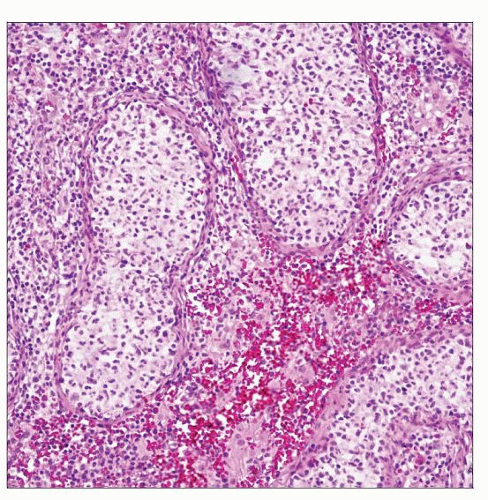Nonspecific Granulomatous Orchitis
Steven S. Shen, MD, PhD
Jae Y. Ro, MD, PhD
Key Facts
Terminology
Mixed chronic and granulomatous orchitis with no specific etiology
Clinical Issues
Usually unilateral testicular enlargement
May be accompanied by tenderness, fever, or heaviness
Microscopic Pathology
Early stage: Mainly intratubular infiltration of histiocytes with destruction of predominantly germ cells, but also Sertoli cells (lesser extent)
Late stage: Tubular destruction and atrophy with extensive fibrosis
Intratubular aggregation of epithelioid histiocytes, plasma cells, and lymphocytes
No well-formed granulomas or necrosis
 Nonspecific granulomatous orchitis is shown. Bivalved testis with ill-defined nodules variably involve the testis and paratestis. Due to the pseudotumorous firm consistency, malignancy is mimicked. |
TERMINOLOGY
Definitions
Mixed chronic and granulomatous orchitis with no specific etiology; may be autoimmune or posttraumatic reaction
ETIOLOGY/PATHOGENESIS
Unknown Causes
Trauma, infection, extravasated sperm, and autoimmune disease have been postulated as possible pathogenetic mechanisms
May be associated with urinary tract infection, history of prostatectomy, and inguinal hernia repair
Autoimmune reaction to sperm antibodies
Vascular compromise with ischemia or infarction
CLINICAL ISSUES
Epidemiology
Incidence
Rare; more common in African-Americans
Age
Range: 29-79 years old (average: 55 years old)
Presentation
Usually unilateral testicular enlargement (more common in right side) but can be bilateral
Stay updated, free articles. Join our Telegram channel

Full access? Get Clinical Tree



